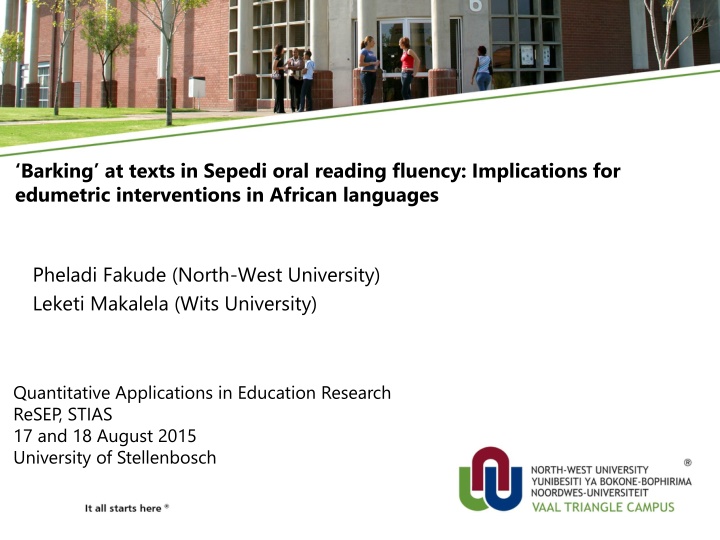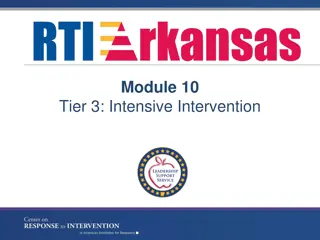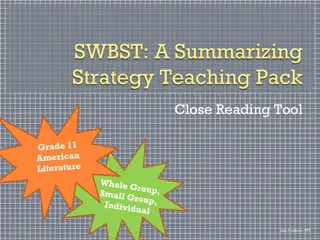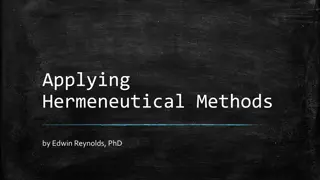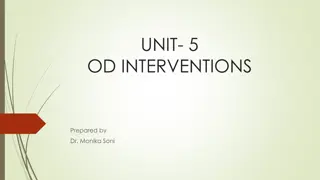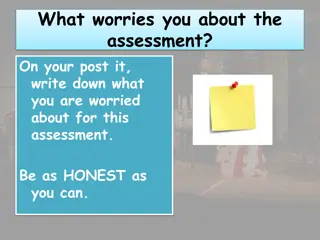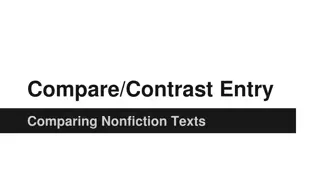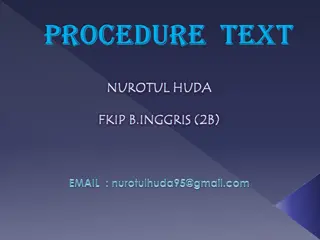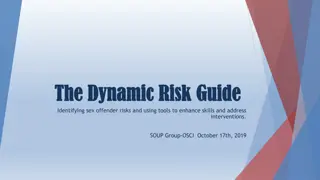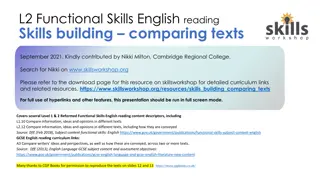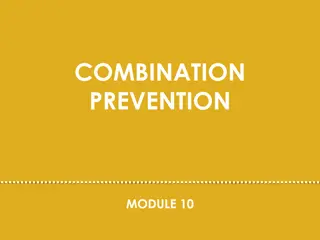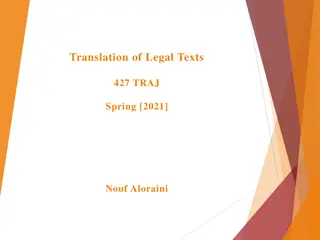Barking at Texts in Sepedi: Implications for Edumetric Interventions
This study explores oral reading fluency in the Sepedi language and its impact on educational interventions for African languages. It discusses the importance of oral reading fluency, research gaps in African language literacy, and findings on reading proficiency among South African primary school children. Theoretical frameworks and components of oral reading fluency are examined to provide insights for teaching and further research in this area.
Download Presentation

Please find below an Image/Link to download the presentation.
The content on the website is provided AS IS for your information and personal use only. It may not be sold, licensed, or shared on other websites without obtaining consent from the author.If you encounter any issues during the download, it is possible that the publisher has removed the file from their server.
You are allowed to download the files provided on this website for personal or commercial use, subject to the condition that they are used lawfully. All files are the property of their respective owners.
The content on the website is provided AS IS for your information and personal use only. It may not be sold, licensed, or shared on other websites without obtaining consent from the author.
E N D
Presentation Transcript
Barking at texts in Sepedi oral reading fluency: Implications for edumetric interventions in African languages Pheladi Fakude (North-West University) Leketi Makalela (Wits University) Quantitative Applications in Education Research ReSEP, STIAS 17 and 18 August 2015 University of Stellenbosch
Outline Introduction Theoretical Framework Hypothesis The study Discussions Concluding remarks
Introduction Oral reading fluency (ORF) has been a hot debate among literacy educators and researchers for at least 30 years in the developed world (Keijzer, 2013; Reschly et al., 2009). It was discovered in the 1970s that fluency is an important skill to measure because it is considered a mark of a skilled reader (Canine et al., 1990) and a reliable predictor of how well children read and comprehend texts (Samuels, 2006a; Fuchs et al., 2001). Curriculum-based measurements (CBM) of ORF rely on accuracy and reading speed, as powerful and reliable predictors of overall reading competence. Aside from lack of research on reading in African languages, the few available studies have tended to focus on comprehension measures such as information recall and anaphoric resolution, almost exclusively in comparison to English reading trajectories (e.g. Makalela,2012; Phokungwana, 2012; Pretorius & Mampuru, 2007).
Introduction ---Cont. Findings from these studies revealed no balanced reading development in African languages and English and that, on the whole, primary school children in South Africa read at least 3 4 years below their expected proficiencies. This study sought to assess two ORF components, automaticity and accuracy, among Grade 4-7 learners home language, Sepedi, as they make their transition between grades and into secondary school education. Suggestions for teaching ORF in African languages and fertile areas for further research on African languages ORF are offered for adaption in comparable contexts.
Theoretical Framework 1 ORF and the Working Memory model: Theorises that mental functions are organised into two slave systems that work in parallel, namely, phonological loop and visuo-spatial sketchpad. Phonological loop Rehearse and maintain linguistic information Visuo-spatial sketchpad Spatial and visual information These two systems are overseen by a central executive system that coordinates attention and ensures that irrelevant information is ignored in complex tasks. The WM model posits that, in the process of developing reading fluency, there is an underlying reader s communication link between two mental slaves: visual and linguistic. Visual slave encompasses orthographic coding operations for visible language written within the visual system. Linguistic slave includes phonological coding operations for spoken words within the oral/aural language system. ORF involve multiple communication links between corresponding orthographic and phonological codes of the same segment size.
Theoretical Framework 2 Automaticity develops as a result of extended practice where complex tasks that were once slow and required more attentional resources gradually become automatic. Comprehension, on the other hand, is not a good candidate for automaticity because it is attention-demanding and increase the cognitive load of the reader. It is in this connection that ORF is understood as an efficient, reliable, and acute predictor of overall reading comprehension. Under broad category of CBM, several measures of ORF have been used with success in the literature on early literacy: Reschly's study that investigated correlations between CBM Oral Reading Measure and other standardised measures for reading achievement in Grades 1-6. They found that ORF was a reliable indicator of reading achievements with no differences in the magnitude of the correlations across the grades.
Theoretical Framework 3 Kim et al. s (2012) study shows more evidence that ORF is a more reliable predictor of reading comprehension than silent reading fluency. Kim et al. s (2012) study also found that ORF was strongly related to reading comprehension in Grade 1, but less so in Grade 2, a finding suggesting that the magnitude of correlations can be grade-dependent. Research on ORF in African languages is unavailable to date to guide edumetric services by teachers and practitioners. As a result, we borrow English benchmarks for ORF in Sepedi, a language with disjunctive orthography, as the first step to developing Sepedi ORF yardsticks. Until such a time that these measures are in place, reading achievements in African languages cannot be measured with accuracy and reliability.
Hypothesis By Grade 7, readers should have Words Correct Per Minute (WCPM) scores of 100 or above. WCPM scores will be differentiated according to schools and Sepedi dialects used by the participants. By Grade 4-6, readers will exceed a benchmark of 50 70 WCPM scores. There will be differential WCPM scores between grade levels.
The study Two samples: Sample 1: 27 Grade 7 participants (n=9/school) Stratified sampling procedure: 3 low achievers, 3 middle achievers and high achievers. Schools (Mopani and Capricorn District) Two Sepedi regional variant: One school with Khelobedu (far from standard Sepedi and two schools with Semmamabolo dialect (close to standard Sepedi) The second sample: 30 Grade 4-6 (10/Grade) Identified by teachers (previously engaged in in-service training). One school: Semmamabolo dialect
The study Material design: Grade 7 Reader: An unpractised 200-word passage was extracted from one of the Grade 7 Sepedi texts, following the norms of CBM. A narrative was preferred to other genres so that it was unobtrusive and less-attention demanding. The text was taken from a story book entitled: A re ogeng thari . Grade 4-6 Reader: The second material was designed for Grades 4 6 ( they were treated as a homogenous group) due to their comparable cognitive capacities and classification into one curriculum category of intermediate phase in the South African education system. To avoid grade-bias, a neutral supplemental text was selected for the Grades 4 6 population. An unrehearsed 200-word extract was taken from a story book entitled, Moeno le se o sa Bakgaga.
Procedure Three indentified schools (A, B and C), the nine Grade 7 learners read the 200-word passage within a minute. A similar procedure was followed in School D (Grades 4 6) to ensure consistency and to minimise the experimenter effect. Guidelines, adopted from Shinn (1989), were used to determine which words were counted as correct: Words read correctly: These included self corrections within 3 seconds, words read incorrectly: (a) mispronunciation, (b) substitutions, (c) omissions, and (d) repetitions. 3-second rule: if a learner is struggling to pronounce a word or hesitates for 3 seconds, the learner is told the word and it is counted as an error. At the end of each session, each error was subtracted from the total number of words read in order to arrive at the score for number of words read correctly per minute. The sessions lasted for about 45 minutes at each of the four schools. Two researchers assessed each child once and compared their scoring for an interater-reliability (2 scores averaged). An interater-reliability of 96% was obtained throughout this testing exercise.
Data Analysis Data was analysed quantitatively: Descriptive statistics to obtain measures of central tendencies (mean) and dispersion (standard deviations). In order to compare the ORF scores across the four schools and between the grade levels, a 2 x one-way ANOVA was computed to measure differences and statistical significance levels that were pitched at an alpha value of 0.05.
Results: Grade 7 Word Correct per Minute scores School School N N Min Min Max Max M (WCPM) M (WCPM) SD SD A 9 20 77 65.0 48.7 B 9 22 72 56.7 47.0 C 9 15 69 66.7 45.5
Results: Differences within and between schools SS SS Df Df MS MS F F P P Between Between 515.3400 515.3400 2 2 257.6700 257.6700 0.1178 0.1178 0.8894 0.8894 Within Within 52512.7200 52512.7200 24 24 2188.0300 2188.0300 Total Total 53028.0600 53028.0600 26 26
Results: Grade 4-6 Words Correct Per Minute scores Grade Grade N N Min Min Max Max M (WCPM) M (WCPM) SD SD 4 10 17 58 54.3 11.9 5 10 18 65 49.8 16.9 6 10 20 68 56.8 21.7
Results: ANOVA: variance in grades progression levels SS SS Df Df MS MS F F P P Between Between 1961.0856 1961.0856 5 5 392.2171 392.2171 0.3301 0.3301 0.8925 0.8925 Within Within 60595.7100 60595.7100 51 51 1188.1512 1188.1512 Total Total 62556.7956 62556.7956 56 56
Discussion 1 The first hypothesis of the study projected lower ORF among Grade 7 readers. As demonstrated in the results, the Grade 7 readers failed to reach a minimum ORF rate of 100 words correct per minute. The second hypothesis projected variance between Grade 7 in schools that were differentiated according to location and dialects of Sepedi. Thirdly, Grade 4 6 readers were found to have no differential WCPM scores from the ORF tasks undertaken. Related to the third finding is the revelation that there is no ORF differentiation between Grades 4, 5, 6 and 7. According to international benchmarks, ORF levels below 70 are characteristics of Grade 1 3 readers where the instructional focus is on learning how to read. Without automated orthographic phonological mapping in the reading process, accurate and paced reading development is difficult to attain.
Discussion 2 Toward edumetric intervention in African languages: ORF test is a helpful way to explain how teachers can use the scores to develop support programmes. ORF tests are used for diagnosis and placement of young readers in special programmes (Hasbrouk & Tindal, 2006). Teachers of Sepedi can use CBM approaches to ensure that their learners are reading at expected grade levels, and ORF measures can also be used to distinguish discrepancies within and between individual learners and to make informed decisions about extra help for the learners. Progressive assessment of ORF among high performing readers will be a first step towards development of Sepedi specific norms.
Discussion 3 The edumetric features of counting the number of correct words for 1 minute in curriculum-based assessments also provide a time-series data to: (a) screen identify students that may need help in becoming skilled readers; (b) diagnose identify readers strengths or weaknesses on reading fluency, and (c) monitor progress ascertain whether the struggling readers are making progress towards the goals of improved reading fluency. CBM procedures allow teachers to collect qualitative data, noting types of coding errors, strategies, miscues and semantic/syntactic features in Sepedi texts that can be highlighted and treated.
Conclusion This study investigated ORF trajectories among Sepedi Grades 4 7 readers in four rural Limpopo primary schools. The results of the study shed some light on and expand our understanding of reading literacy challenges in South Africa and more specifically explain why primary school readers are four years below their instructional levels. The results of the study showed that there are no accuracy and rate gains in the readers ORF as they progress from one grade to the next. ORF level is classified as basal, requiring both remedial and edumetric attention. Intermediate phase and senior phase readers fail to make the transition from learning to read to reading to learn in their home language. The lack of automated phonological-orthographic mapping is a strong indicator that the readers overall reading competence is weak in their home language.
Conclusion cont ORF results show a slow, inaccurate reading process that compares to a barking phenomenon, which we define as making incomprehensible noises towards a text without adequate intonation, rate and accuracy that match natural speech. The results also provide educational opportunities for teachers of Sepedi, and other related African languages, to conduct CBM assessments continuously in order to monitor, evaluate and take focused decisions regarding extra reading support for struggling readers. The ORF tests provide a fertile ground for further research to develop reading norms in African languages that can be benchmarked with reading developments in other languages. More qualitative studies that look at the typical decoding errors as well as the three step edumetric features (i.e., screening, diagnosing, and progress monitoring).
Remarks 24474134@nwu.ac.za Barking at texts in Sepedi oral reading fluency: Implications for edumetric interventions in African languages Thank you! Ke a leboga! Baie Dankie!
